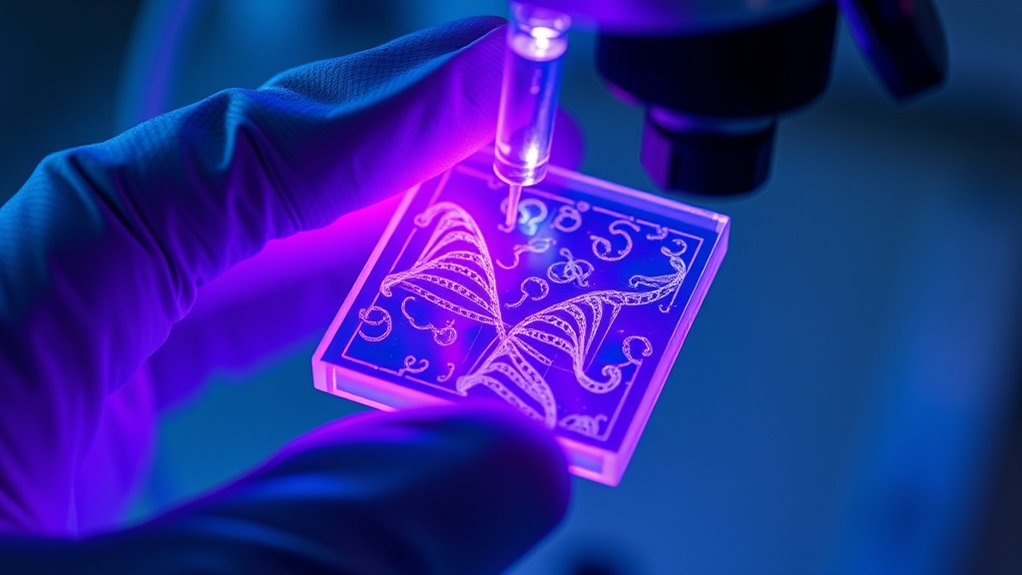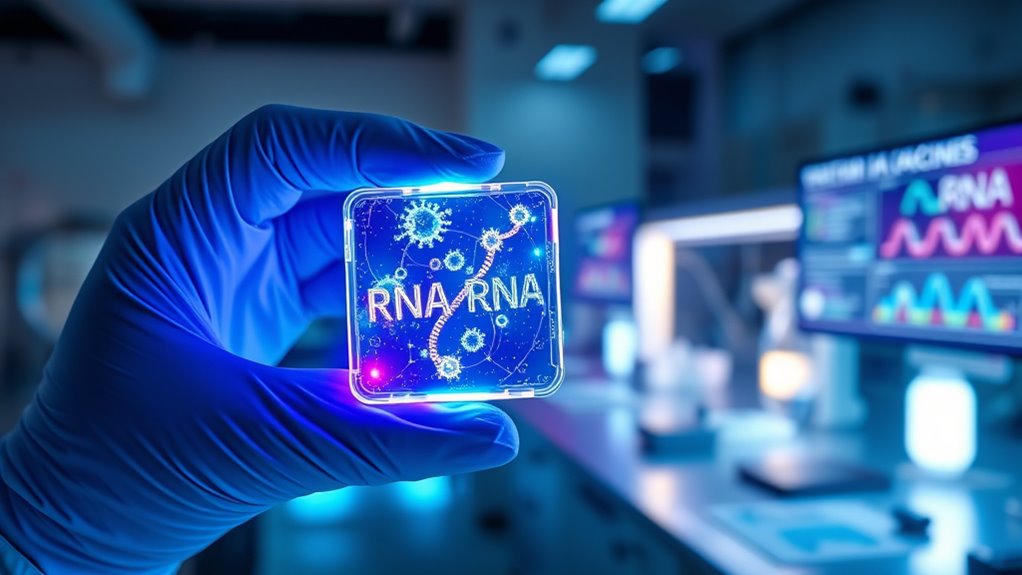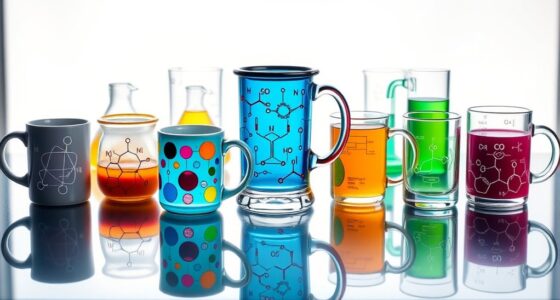mRNA vaccines use synthetic messenger RNA to teach your cells how to produce a viral protein, like the spike protein from COVID-19. Once inside your cells, the mRNA is translated into proteins that trigger your immune system to respond without using live viruses. Lipid nanoparticles protect the mRNA and help it enter cells. This innovative tech speeds up vaccine development and can adapt quickly to new variants. Keep exploring to learn more about how this breakthrough works.
Key Takeaways
- mRNA vaccines use synthetic messenger RNA to instruct cells to produce viral proteins, triggering an immune response.
- Lipid nanoparticles protect mRNA and facilitate its entry into cells, where ribosomes translate it into viral antigens.
- mRNA vaccines do not alter human DNA and degrade quickly after delivering instructions, ensuring safety.
- Their modular design allows rapid updates for new variants, enabling quick responses to emerging health threats.
- They stimulate immunity by presenting viral proteins to immune cells, activating T and B cell responses for protection.
What Are Mrna Vaccines?

Have you ever wondered how mRNA vaccines work? These vaccines use a synthetic copy of messenger RNA to trigger your immune system.
Instead of using a live virus, they encode a specific viral protein, usually from the virus’s outer membrane. When injected, the mRNA enters your cells’ cytoplasm, where ribosomes read it and produce the viral protein.
This protein acts as an antigen, prompting your immune system to respond. Importantly, the mRNA doesn’t enter the nucleus or alter your DNA; it’s quickly degraded after producing the protein. mRNA technology can be adapted quickly to target different pathogens, making it a versatile tool in vaccine development. The stability and delivery of mRNA are enhanced by lipid nanoparticles, which help protect and transport it efficiently into cells.
The Science Behind How They Work

When mRNA vaccines enter your body, they rely on a sophisticated process to activate your immune system. The vaccine delivers synthetic mRNA, which is protected by lipid nanoparticles to prevent degradation and help it enter your cells through endocytosis.
Once inside the cytoplasm, your ribosomes translate the mRNA into viral protein antigens, like the spike protein of SARS-CoV-2. The mRNA stays in the cytoplasm and doesn’t integrate into your DNA.
These proteins are processed into peptide fragments, which bind to MHC molecules and are transported to your cell surface. Dendritic cells efficiently absorb the mRNA and present the antigens to immune cells in lymph nodes.
This triggers an immune response, activating T cells and B cells, leading to antibody production and cellular immunity. mRNA stability plays a crucial role in ensuring the effectiveness of the vaccine and proper immune activation.
Key Ingredients in Mrna Vaccines

The key ingredients in mRNA vaccines work together to guarantee safety and effectiveness. The mRNA molecule carries genetic instructions to produce the SARS-CoV-2 spike protein, triggering your immune response. It’s a synthetic, non-infectious strand that’s protected until it reaches your cells. mRNA does not interfere with human DNA and naturally degrades within 1-2 weeks. Lipid nanoparticles (LNPs) encase the mRNA, shielding it and helping it fuse with your cell membranes, allowing entry. These lipids include specific components like SM-102 or ALC-0315 and PEG-conjugated lipids to stabilize particles. Salts and buffers maintain the vaccine’s pH and stability, ensuring it works properly during storage and injection. Sugars like sucrose act as cryoprotectants, preventing damage during freezing. Other trace ingredients, such as acids, help maintain the right pH, all designed to keep the vaccine safe and effective. Additionally, vaccine stability is enhanced by precise formulation to ensure efficacy throughout storage and handling.
Advantages of Using Mrna Technology

mRNA technology offers several significant advantages that have transformed vaccine development and healthcare. You can develop vaccines much faster since mRNA doesn’t need live viruses or traditional cultivation processes. This speed allows you to respond quickly to outbreaks or new variants, helping control diseases more effectively. Additionally, ongoing innovations in AI-driven security systems and data analytics are supporting the rapid development and monitoring of vaccine efficacy. Production is scalable and cost-efficient because mRNA vaccines are made in cell-free environments, reducing manufacturing time and expenses. They’re non-infectious and don’t alter your DNA, minimizing safety concerns. Plus, these vaccines tend to have lower reactogenicity, making them well-tolerated. Their high efficacy, combined with the ability to adapt swiftly to emerging strains, ensures ongoing protection. Overall, mRNA technology offers a fast, safe, and versatile platform that benefits public health and accelerates medical innovation.
Overcoming Challenges and Concerns

Overcoming challenges and concerns with mRNA vaccines requires addressing issues related to stability, delivery, safety, and public perception. You’ll find that researchers are working on formulations that improve shelf life at higher temperatures, easing distribution. Delivery methods are evolving to protect mRNA until it reaches target cells, minimizing degradation. Safety concerns like myocarditis are closely monitored, with modifications reducing risks. Transparent communication and education help build public trust, clarifying how the technology works and its benefits. To illustrate, consider this:
| Challenge | Solution | Impact |
|---|---|---|
| Stability & Storage | Improved formulations & LNPs | Easier distribution in low-resource areas |
| Delivery | Advanced LNPs & injection techniques | Better targeting & fewer side effects |
| Safety | Nucleotide modifications & monitoring | Reduced adverse effects |
| Public Perception | Transparency & education | Increased confidence |
Additionally, ongoing research is focused on enhancing the vaccine stability, which is crucial for expanding access worldwide.
The Future of Mrna Vaccines and Medical Applications

As research advances, the future of mRNA vaccines and medical applications looks promising, with expanding use beyond infectious diseases into cancer treatment and personalized medicine. You’ll see mRNA technology being developed for a broader range of infectious diseases like influenza, dengue, and Ebola, thanks to its adaptability for quick updates and responses to new threats. Researchers are also harnessing mRNA to create personalized cancer vaccines that teach your immune system to target specific tumor mutations, offering a precise therapeutic approach. Additionally, ongoing improvements aim to boost vaccine potency and durability, reducing doses needed and enhancing protection. The flexibility of mRNA platforms allows for rapid adaptation to emerging health challenges, ensuring timely responses to global health threats. Moreover, ongoing research emphasizes the importance of immune response mechanisms, which are critical for optimizing vaccine efficacy. Beyond vaccines, mRNA is exploring treatments for genetic disorders and chronic infections, potentially transforming healthcare by enabling tailored, effective therapies for a wide array of conditions.
How Mrna Vaccines Are Developed Quickly

The rapid development of mRNA vaccines hinges on their ability to quickly leverage genetic information from emerging pathogens. Once the virus’s genetic sequence is known, you can design an mRNA that encodes the virus’s spike protein in just days.
Synthetic manufacturing of the gene inserted into a plasmid speeds up the process, allowing in vitro transcription to produce mRNA efficiently. This process bypasses traditional steps like virus cultivation or protein production.
The mRNA is then encapsulated in lipid nanoparticles, which protect it and facilitate delivery into cells.
Because the platform is modular, changing the vaccine to target new variants only requires tweaking the sequence, not redoing the whole process. This flexibility, combined with streamlined regulatory pathways, enables rapid response during health emergencies.
Ensuring Safety and Efficacy

Ensuring the safety and efficacy of mRNA vaccines involves rigorous testing through large-scale clinical trials and ongoing surveillance. You can see this in the results from Moderna’s trial with over 30,000 volunteers, which showed 94.1% effectiveness, and Pfizer-BioNTech’s trial with 43,548 participants, demonstrating 95% efficacy. Alimony laws No serious safety concerns emerged during these studies. Data from children and adolescents confirm that vaccines substantially reduce infection, hospitalization, and severe outcomes, with mostly mild side effects. Post-authorization monitoring continues to track adverse events, revealing most are mild and transient, with serious issues remaining rare. The vaccines’ design — producing spike proteins without using live viruses — guarantees a strong immune response while maintaining safety across diverse populations.
The Global Impact of Mrna Vaccines

Global research efforts on mRNA vaccines involve over 120 countries, with the U.S., China, and Italy leading in publications and development. The U.S. contributes the most, with 1,368 publications, while China and Italy follow with 487 and 454 respectively. Regions like North America, Europe, and Asia are at the forefront of research, though some areas remain underrepresented. Despite widespread participation, global access remains unequal, and manufacturing expansion faces scalability challenges. Public perception varies, with social media spreading both support and misinformation, fueling vaccine hesitancy, especially among women. Nevertheless, mRNA vaccines have profoundly impacted global health, aiding pandemic response and routine immunization efforts. The importance of high-quality research and precise technological development continues to drive progress in this field. Their technological advancements promise further applications, supporting worldwide recovery and future disease prevention.
Frequently Asked Questions
How Long Does Immunity From Mrna Vaccines Last?
You might wonder how long immunity from mRNA vaccines lasts. Typically, protection against severe COVID-19 remains strong for several months, even after antibody levels decline.
However, antibody responses tend to wane within a few months, potentially increasing susceptibility to infection. Boosters can help prolong immunity, keeping you better protected, especially against new variants.
Are Mrna Vaccines Suitable for Children and Pregnant Women?
You might wonder if mRNA vaccines are suitable for children and pregnant women. The evidence shows they’re generally safe and effective for children aged 5 to 11, reducing severe illness and hospitalization risks.
For pregnant women, vaccines are recommended because the benefits outweigh potential risks, helping prevent severe COVID-19. While ongoing research continues, current data supports their use, making them a valuable tool for protecting vulnerable groups.
What Are Common Side Effects of Mrna Vaccines?
Imagine feeling sore and tired after getting vaccinated—many people experience this.
Common side effects of mRNA vaccines include pain, redness, and swelling at the injection site. You might also feel fatigue, headaches, muscle or joint pain, chills, or mild fever.
In rare cases, some may experience allergic reactions or heart-related issues like myocarditis. These symptoms are usually temporary and part of your body’s natural response to the vaccine.
Can Mrna Technology Be Used for Non-Infectious Diseases?
Yes, you can use mRNA technology for non-infectious diseases. It’s being explored for cancer immunotherapy, where it helps your immune system target tumor cells by encoding specific antigens.
Researchers also use it to produce functional proteins for genetic disorders, like cystic fibrosis, and to modulate immune responses in autoimmune diseases.
Additionally, mRNA aids in regenerative medicine by instructing cells to produce proteins necessary for tissue repair and healing.
How Do Mrna Vaccines Compare to Traditional Vaccine Methods?
You see that mRNA vaccines differ from traditional ones in how they work and develop. They give your cells genetic instructions to produce a viral protein internally, triggering your immune response quickly and safely.
They can be made faster, especially during pandemics, and don’t risk causing infection. However, they often need ultra-cold storage, unlike traditional vaccines, which are easier to keep and distribute but may take longer to develop and adapt.
Conclusion
Imagine building a sturdy bridge in record time, connecting two distant points safely. That’s what mRNA vaccines do—they rapidly bridge the gap between scientific discovery and global health. With over 10 billion doses administered worldwide, they’ve proven their power to fight pandemics and beyond. As you now understand, this innovative technology isn’t just a fleeting trend; it’s shaping the future of medicine, offering hope and protection across the globe.









